 The 1922 art week only existed thanks to coffee growers interested in São Paulo as a cultural leader. Modernism was reborn. Attendance at the art exhibition in the entrance hall, which featured works by Anita Malfatti, Di Cavalcanti, Rego Monteiro and sculptor Victor Brecheret, among others, was free, and the event included musical performances, ballets, poems and lectures.
The 1922 art week only existed thanks to coffee growers interested in São Paulo as a cultural leader. Modernism was reborn. Attendance at the art exhibition in the entrance hall, which featured works by Anita Malfatti, Di Cavalcanti, Rego Monteiro and sculptor Victor Brecheret, among others, was free, and the event included musical performances, ballets, poems and lectures.
Among the intellectuals and artists present, Oswald and Mário recited poems and spoke about modern aesthetics. Villa-Lobos had works performed on all three days of the Week, and the piano star, Guiomar Novaes – who was not a modernist at all – delighted the audience.
It certainly left a legacy. The fact is that the 1922 Art Week was an important accelerator for Brazilian culture as coffee was for the economy. The Modern Art Week left fruits that continue to multiply. Very good investment, coffee growers!
 COFFEE GROWER
COFFEE GROWER
One who is dedicated to coffee cultivation. Etymology (origin of the word coffee grower). Coffee + cultivator. Coffee growing is the agricultural activity that consists of producing coffee, a drink enjoyed in several countries as we all know. Brazil is the largest coffee producer in the world and coffee growing is an activity of great economic and historical importance for the country.
Thus, from the art of nature, of our terroirs and mountains, to the technique of harvesting and production, our coffee is treated as artistry. From cultivation, production, storage and processing, everything is carefully reflected in our coffee, which is a true fine art.
 Q-GRADER
Q-GRADER
Our Q-Grader is one of the most renowned professionals in the field. A wizard. He is our coffee expert, capable of analyzing the specificities of the beans through tasting, working together with other professionals on our team to ensure that only the best coffees reach the market and, consequently, your cup.
He is the “certifier” of quality in the world of coffee, just as the sommelier is in the world of wine. Our Mauro evaluates all the attributes of the coffee, from fragrance/aroma to uniformity, absence of defects, sweetness, flavor, body, completion and, finally, balance.

MUSIC
Yes, we are musical! Music is an art form characterized by working with the harmony of sounds, rhythms, melodies and voices.
Music is a language that can be present at various moments in life and can play an important role in the formation of human beings. Music can be classified as a performing, sublime or spectacle art. It is immaterial, momentary and tied to time, requiring an intermediary to exist, that is, someone to perform it.
Music can transport people to other times and places, bring back memories and rekindle emotions. The relationship between music and painting can be interesting, as visual elements can evoke rhythm, while a melodic composition can awaken sensations that lead to the perception of color and shape. And that’s what our coffee is like!
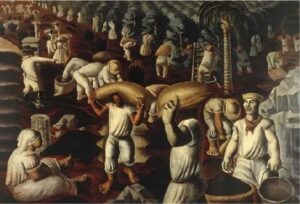
CANDIDO PORTINARI
Candido Portinari is considered one of Brazil’s most important artists. The painting Café (a lively painting depicting life on a plantation, with men and women carrying sacks of coffee beans) is considered his masterpiece. For it, the artist received the second honorable mention at the Carnegie Institute’s International Exhibition of Modern Art in New York.
Since he was born on a coffee farm, this theme appeared frequently in his work. In this painting, he portrays the hard daily work carried out by women and men on a coffee plantation. It is a realistic and symbolic portrait of the time when coffee was considered Brazil’s green gold.
 MAURO BENEDETTI
MAURO BENEDETTI
Renowned coffee specialist, with over 40 years in the market, largely focused on the development of blends for the international market, arrives at unique blends made with the best coffee beans in the country. He serves also as judge in the main coffee competitions in the country, and has been awarded several times for the consistency and quality of his work. Our coffees are made to meet the most demanding palates.
 EDUARDO KOBRA
EDUARDO KOBRA
Born in the South Zone of São Paulo, Kobra has become one of the most renowned muralists of our time, with works on five continents. Since the 2016 Summer Olympics in Rio de Janeiro, Kobra has held the record for the largest graffiti mural in the world – first with ‘Etnias’, painted to celebrate the event, covering 2,500 square meters; a record he surpassed in 2017, with a work depicting a simple worker on a cocoa farm that occupies a 5,742 square meter wall on the side of the Castelo Branco highway, in the metropolitan region of São Paulo. One of his most famous works is The Kiss, painted in 2012 on the High Line in New York, and erased four years later.
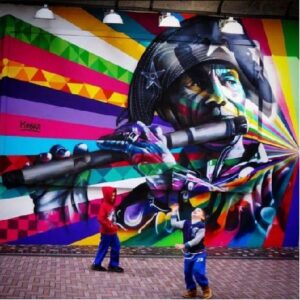
In 2022, at the invitation of the United Nations, he created a panel measuring almost 400 square meters, which was exhibited at the organization’s headquarters in the United States. At the same time, the interior of the building housed an exhibition of his works. In August 2023, he prepared a work especially for exhibition at the FAMA Museum, one of the largest private museums in Latin America, located in Itu, in the interior of São Paulo.
During the celebrations for the 100th anniversary of the Modern Art Week, Kobra was part of an artistic show held by the Teatro Municipal de São Paulo, with a live intervention, simultaneously with the performance of the Orquestra Sinfônica Municipal de São Paulo. In the second half of 2022, the documentary ‘Kobra – Auto Retrato’ was released, a work by filmmaker Lina Chamie about the artist’s life. The film was well received by audiences and critics alike and, after a run in theaters, is available on several streaming platforms. In August 2023, it won the Grande Prêmio do Cinema Brasileiro, the most important recognition in the category in the country. rs later.
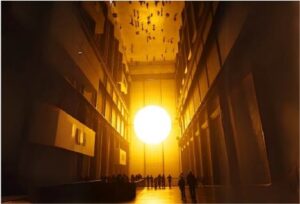 NEON ART
NEON ART
Neon light art is an unique and captivating form of contemporary art that uses neon lights to create vibrant and colorful sculptures and installations. The art form emerged in the early 20th century and gained popularity in the 1950s and 1960s, particularly in advertising and commercial signage. However, since then, neon light art has evolved into a respected art form, with artists using neon lights to create complex and innovative works that explore a variety of themes and ideas. From dazzling public installations to intimate gallery exhibitions, neon light art continues to captivate audiences with its mesmerizing glow and stunning visual impact.
 Neon light artists often use glassblowing and bending techniques to shape the neon tubes, and may also incorporate other materials, such as metal, wood, and plastic, into their works. Neon light art can be found in a variety of settings, from public spaces and commercial buildings to galleries and museums, and continues to push the boundaries of what is possible with this unique and captivating medium. Neon art is characterized by its use of bright, vibrant colors and its ability to create a sense of movement and energy – just like RDR Coffees.
Neon light artists often use glassblowing and bending techniques to shape the neon tubes, and may also incorporate other materials, such as metal, wood, and plastic, into their works. Neon light art can be found in a variety of settings, from public spaces and commercial buildings to galleries and museums, and continues to push the boundaries of what is possible with this unique and captivating medium. Neon art is characterized by its use of bright, vibrant colors and its ability to create a sense of movement and energy – just like RDR Coffees.
 TCHAIKOVSKY
TCHAIKOVSKY
Pyotr Ilyich Tchaikovsky (Russian: Пётр Ильи́ч Чайко́вский; May 7, 1840 – November 6, 1893) was a Russian composer of the Romantic period, whose works are among the most popular in the classical repertoire. The first Russian composer to achieve international fame, his career was boosted by his participation as a guest conductor in other European countries and the United States. In recognition of this, in 1884 he was honored by Emperor Alexander III.
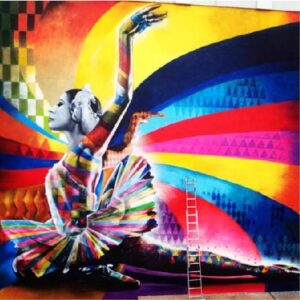 He remains one of the most frequently performed composers of the classical repertoire. His best-known works include the ballets Swan Lake, The Nutcracker, and The Sleeping Beauty; the 1812 Overture and the fantasy overture Romeo and Juliet; his concerts for piano and orchestra and for violin and orchestra; his fourth, fifth, and sixth symphonies; his Slavonic March; and his operas Yevgeny Onegin and The Queen of Spades.
He remains one of the most frequently performed composers of the classical repertoire. His best-known works include the ballets Swan Lake, The Nutcracker, and The Sleeping Beauty; the 1812 Overture and the fantasy overture Romeo and Juliet; his concerts for piano and orchestra and for violin and orchestra; his fourth, fifth, and sixth symphonies; his Slavonic March; and his operas Yevgeny Onegin and The Queen of Spades.
 TOM JOBIM
TOM JOBIM
Antônio Carlos Brasileiro de Almeida Jobim (Rio de Janeiro, January 25, 1927 – New York, December 8, 1994), better known by his stage name Tom Jobim, was a Brazilian composer, pianist, guitarist, arranger, flautist and singer. Considered one of the great exponents of Brazilian music, Jobim internationalized bossa nova and, with the help of important American artists, fused it with jazz in the 1960s to create a new sound that was popularly successful. For this reason, he is sometimes known as the “father of bossa nova”.
His songs have been performed by many singers and instrumentalists internationally since the early 1960s. In 1965, the album Getz/Gilberto was the first jazz album to win the Grammy Award for Album of the Year. He also won the award in the categories of Best Jazz Instrumental Album and Best Produced Album.
 The single from the album “Garota de Ipanema”, composed by Jobim, became one of the most recorded songs of all time and the album won the Recording of the Year award. Jobim composed many songs that are now part of the classic jazz and pop repertoires. “Garota de Ipanema” has been recorded more than 240 times by other artists. His 1967 album with Frank Sinatra, Francis Albert Sinatra and Antônio Carlos Jobim, was nominated for Album of the Year in 1968. In a 2022 survey, produced by ECAD, Tom has 8 of the 15 most re-recorded Brazilian songs in history, counting solo or collaborative songs, the most re-recorded being Garota de Ipanema, which he wrote in partnership with Vinicius de Moraes.
The single from the album “Garota de Ipanema”, composed by Jobim, became one of the most recorded songs of all time and the album won the Recording of the Year award. Jobim composed many songs that are now part of the classic jazz and pop repertoires. “Garota de Ipanema” has been recorded more than 240 times by other artists. His 1967 album with Frank Sinatra, Francis Albert Sinatra and Antônio Carlos Jobim, was nominated for Album of the Year in 1968. In a 2022 survey, produced by ECAD, Tom has 8 of the 15 most re-recorded Brazilian songs in history, counting solo or collaborative songs, the most re-recorded being Garota de Ipanema, which he wrote in partnership with Vinicius de Moraes.
 GRAPHIC DESIGNER
GRAPHIC DESIGNER
Graphic design is the area of knowledge and specific professional practice related to the aesthetic-formal arrangement of textual and non-textual elements that make up graphic pieces intended for reproduction with an expressly communicational purpose. It is a way of visually communicating a concept or an idea through formal techniques.
We can also consider it as a means of structuring and shaping printed communication, in which, in general, the relationship between ‘image’ and text is worked on. At the beginning of the 21st century, the participation of graphic design expanded to digital media, being used in the creation of websites, electronic portals, software and several other areas related to digital design.
 It is not just a mere performer, but rather a creative conductor who has in mind a communicational objective achieved almost always through design methodologies that help him design. At RDR Coffees, this art is developed by Odair de Brito.
It is not just a mere performer, but rather a creative conductor who has in mind a communicational objective achieved almost always through design methodologies that help him design. At RDR Coffees, this art is developed by Odair de Brito.
ODAIR DE BRITO
Odair de Brito is our Webdesigner and responsible for Technical Support, adding value to our business.
He lived for many years in the south of Minas Gerais, surrounded by coffee plantations, where he learned to taste and learned more about the coffee – this very special fruit admired all over the world.
 CHUCK MITCHELL
CHUCK MITCHELL
Chuck Mitchell is the artist behind the iconic façade of BBKing’s Blues Club on Beale Street in Memphis, Tennessee. His art is honored in the print of our Bourbon Blues, an iconic coffee. We have thus combined in an award-winning coffee, BBKing’s music, Mitchell’s neon art, Heidi Kade’s photography with the audacity of our Odair and the delicacy of Mauro to give rise to a piece of art with RDR Coffees DNA.
 GRAFFITI
GRAFFITI
Graffiti is an artistic expression created in public spaces. This art emerged from the reality of the urban periphery and highlights social criticism. Graffiti art is an artistic expression that takes place in public spaces. The production is materialized on walls that make up the urban environment through spray paint. Graffiti artists express narratives of the city, diverse issues that cross social reality, proposing criticism and reflections through the shapes, colors and lines on the walls.
Along with other artistic expressions, graffiti is part of the popular culture of hip hop, which translates street experiences through art. Graffiti is an artistic expression that takes place in public spaces. In the 1970s, in the outskirts of New York, young people expressed their social struggles through graffiti and promoted street art.
 PHOTOGRAPHERS
PHOTOGRAPHERS
A photographer (the Greek φῶς (phos), meaning “light”, and γραφή (graphê), meaning “drawing, writing”, together meaning “drawing with light”) is a person who uses a camera to make photographs. We can all do, but it must have passion, discipline, talent and the proper tecnique do perform it well. In Bourbon Blues case we exposed a piece of art from Heidi Kade’s angle.
She loves to travel and explore nature and cities all over the world. Her most favorite thing to do is to take photos of her adventures and capture the essence of the moment. So please have a blast and capture the essence of our Bourbon Blues.
 LEADER
LEADER
Leading is an art that requires a series of skills and knowledge. It is a skill that goes beyond giving orders and demanding things from the team, and requires the leader to be an example, ethical, proactive and capable of creating the conditions for the team to achieve its goals. Leading is a true art, and good leaders are scarce in the market.
After all, the person needs to have a series of skills, ranging from knowing how to relate to others to working well in a team and having technical knowledge of the area. Leading means inspiring and motivating people so that they can access the best within themselves, so that they can contribute more productively and effectively to the success of the environment in which they are inserted.
In our case, we have a music lover behind us, in addition to the historical coffee industry. Since childhood, Rodrigo has been accustomed to listening to everything from classical music to rock, including blues, jazz, bossa nova, samba, pop.. his parents encouraged him to learn how to play the piano, an instrument that he practiced for seven years. He also learned to play the guitar, flute and sang in a choir.
 He studied music for five years. Since school, Rodrigo has been a leader, when he was named president of his high school graduation committee, he represented Canada on the Junior Security Council in a United Nations simulation course at his high school, as well as in sports, joining his high school basketball team, later making the national team and finally being selected as one of the bests in the country.
He studied music for five years. Since school, Rodrigo has been a leader, when he was named president of his high school graduation committee, he represented Canada on the Junior Security Council in a United Nations simulation course at his high school, as well as in sports, joining his high school basketball team, later making the national team and finally being selected as one of the bests in the country.
His leadership on court helped him win titles, shaped his personality, leading him to be invited to the World Scholar-Athlete Games, while he was a student. Later on, his leadership was reflected in his professional and academic resume. Rodrigo is a coffee lover, music and art enthusiast and advocate. Such love, talent, experience, heritage and coffee DNA led Rodrigo to assume leadership positions within his family’s farms and later in partnerships. That’s when the modern RDR Coffees was born.
RODRIGO DORA
Rodrigo Dora was born in Brasília, Brazil. He graduated in Law from UniCeub Brasília, with a postgraduate degree in Tax Law from Gama Filho University, Rio de Janeiro. Master in Auditing and Strategic Management from the University of Leon, Spain.
Master in International Trade Law from the University of Liverpool, UK. He also lists several other courses in accounting, economics, law and politics, some of which are from the University of Hong Kong, People’s Republic of China, Leiden University, Netherlands, Lund University of Sweden, University of Michigan and Yale University in the USA, among others.
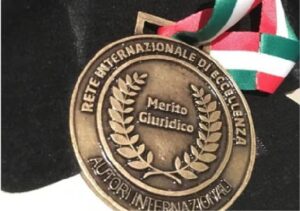 Rodrigo was Commended in 2012, receiving one of the highest decorations of the Brazilian Legislative Assembly, the Tiradentes Commendation, as a Knight Commander, was also Honorary Commissioner of the Sri Lanka Tea Council in Brazil from 2012-2014, and is currently a member of the board of the Brazilian Academy of Arts, Culture and History, and was part of the Golden Chariot Transport Award, is a member of the Brazilian Chapter of the BRICS Business Council in the Agribusiness Working Group, among others.
Rodrigo was Commended in 2012, receiving one of the highest decorations of the Brazilian Legislative Assembly, the Tiradentes Commendation, as a Knight Commander, was also Honorary Commissioner of the Sri Lanka Tea Council in Brazil from 2012-2014, and is currently a member of the board of the Brazilian Academy of Arts, Culture and History, and was part of the Golden Chariot Transport Award, is a member of the Brazilian Chapter of the BRICS Business Council in the Agribusiness Working Group, among others.
As a philanthropist, Rodrigo supports the Batucar Institute and the Pro-Carnivores Institute. In addition, he is an International Advisor to the Commission on the Rights of Children, Adolescents and Youth of the Brazilian Bar Association. Rodrigo Dora received the Medaglia de Autori Giuridicci Internazionalli from the Universitat Degli Studi di Bari in Italy. Rodrigo is fluent in English, Spanish, Portuguese and French.
As a speaker, Rodrigo has participated in many forums and courses, including the final class of the 2015 International Relations graduating class at Univates University in Brazil, the 2016 Walsh College classes in Troy, Michigan, and also, including the 2016 United Nations Civil Society Forum, the BRICS Cities Forum in Harbin, China and the BRICS Civil Forum in Moscow in 2015, among others.
In recent years, Rodrigo has developed the business and institutional activities of RDR Coffees globally, also serving as Executive Director of the Chamber for the Promotion and Economic Development of the BRICS countries, and is firmly involved in the coffee sector, as a producer and member of the Brazilian Coffee Growers Association. Rodrigo also has extensive experience as an exporter of the commodity and in the derivatives market, namely in Arabica coffee contracts.
 RODRIGO’S ARRIVAL
RODRIGO’S ARRIVAL
The history of RDR COFFEES internationally begins with the return of Rodrigo Dora to Brazil in 2017, bringing with him a great desire to prosper in all family’s and partners’ businesses, with a special emphasis on coffee agribusiness.
MORE AND MORE PLOTS OF LAND. In a few years, Rodrigo bought more pieces of land and leased as many others, maintaining and in other cases starting the planting of coffee. It prospered quickly and expanded its production throughout the borders of Minas Gerais/São Paulo. In the mid-2000s, the family continued to expand to the south of Minas Gerais and from 2020 onwards, it reached the north of Minas Gerais.